Chicken Cacciatore
- By Jennifer Segal
- Updated November 6, 2025
- 168 Comments
- Leave a Review

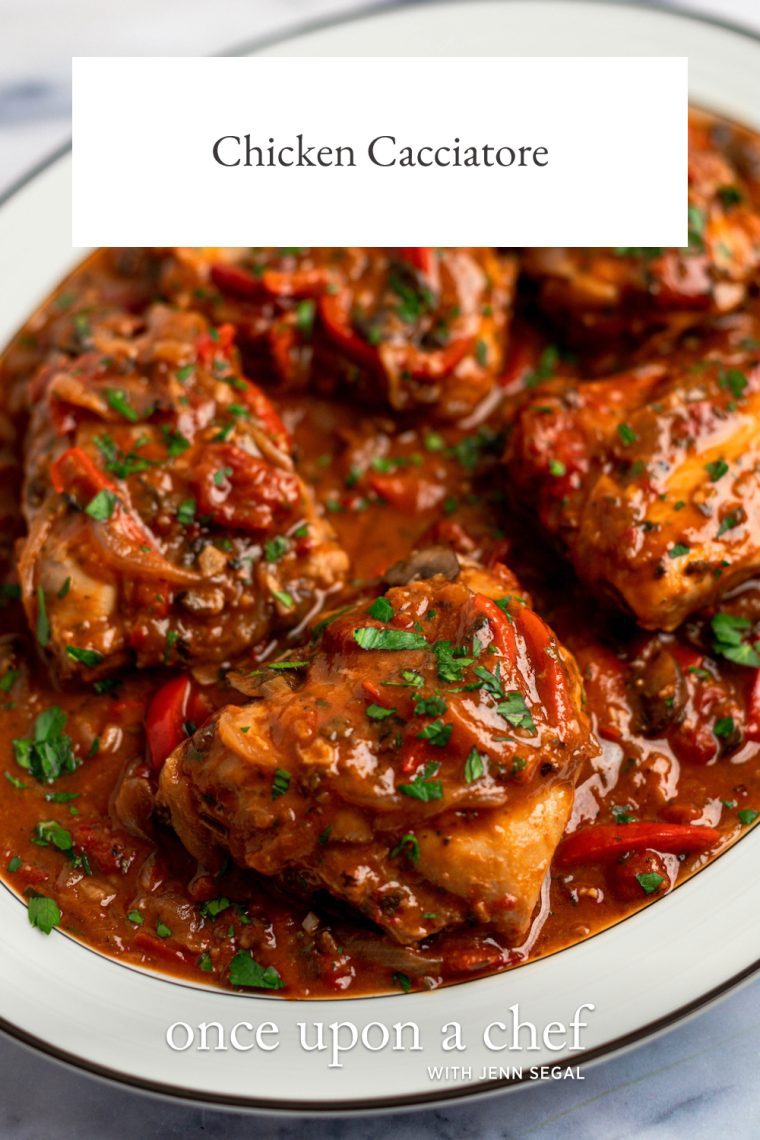
This post may contain affiliate links. Read my full disclosure policy.
Chicken cacciatore is the ultimate Italian comfort food. With its rich, hearty sauce and layers of flavor, it’s just the thing for a chilly night.

Chicken Cacciatore, also known as Hunter’s Chicken, is a classic Italian dish brimming with rich, rustic flavor. The name cacciatore means “hunter” in Italian, and legend has it that hunters would prepare it over an open fire using whatever ingredients they had on hand. In this version, tender chicken thighs are simmered in a hearty tomato and red wine sauce with peppers, onions, and herbs until the meat practically falls off the bone. It’s cozy, comforting, and perfect for spooning over creamy polenta or Parmesan smashed potatoes.
“Followed the recipe exactly as written and served over polenta. Outstanding!!!”
What You’ll Need To Make Chicken Cacciatore Recipe
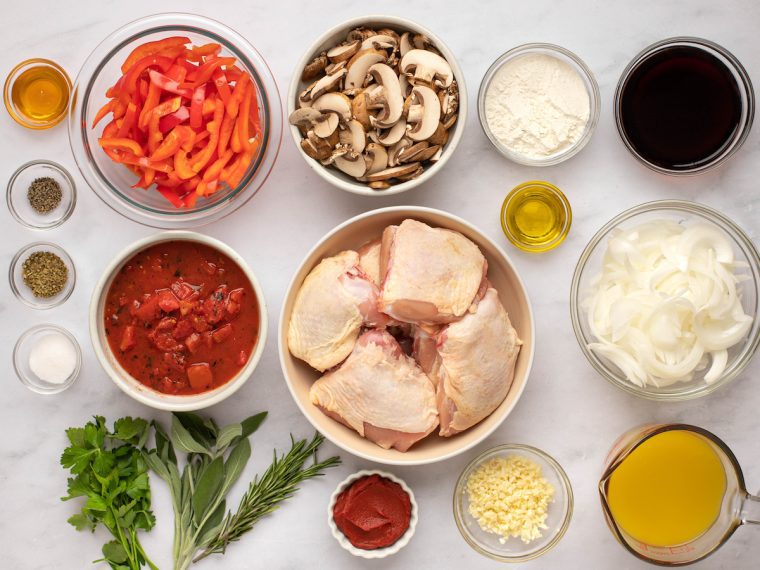
Step-by-Step Instructions
Step 1: Prep, dredge, and brown the chicken. Blot the chicken with paper towels, season with salt and pepper, and dredge in flour. Heat some oil in a large Dutch oven or heavy skillet over medium-high heat, then add the chicken and cook until it’s golden and crisp.


Once it’s browned, move it to a plate and set it aside while you build the sauce.

Step 2: Sauté the vegetables. Pour off all but a couple tablespoons of fat from the pan. Lower the heat and add the onions, cooking until they’re softened and lightly browned. Stir in the garlic and cook for another minute until it smells nice and fragrant. Add the mushrooms and peppers, and cook for about 5 minutes, just until they start to soften.


Step 3: Add the wine. Pour in the wine and let it boil until it’s mostly evaporated—this concentrates the flavor and cooks off the sharpness of the alcohol.

Step 4: Simmer the sauce and cook the chicken. Stir in the broth, tomatoes, tomato paste, herbs, honey, and salt, and simmer for 10 minutes. Return the chicken and any juices to the pot and cook for about 35 minutes, until tender and cooked through. Discard the skin (it adds flavor but gets soggy), and let the sauce simmer a bit longer to thicken. Return the chicken to the pot and simmer together for a few more minutes.




Step 4: Garnish and serve. Sprinkle the chicken with chopped parsley and enjoy! This dish can be made up to 3 days in advance and also freezes well for longer storage.
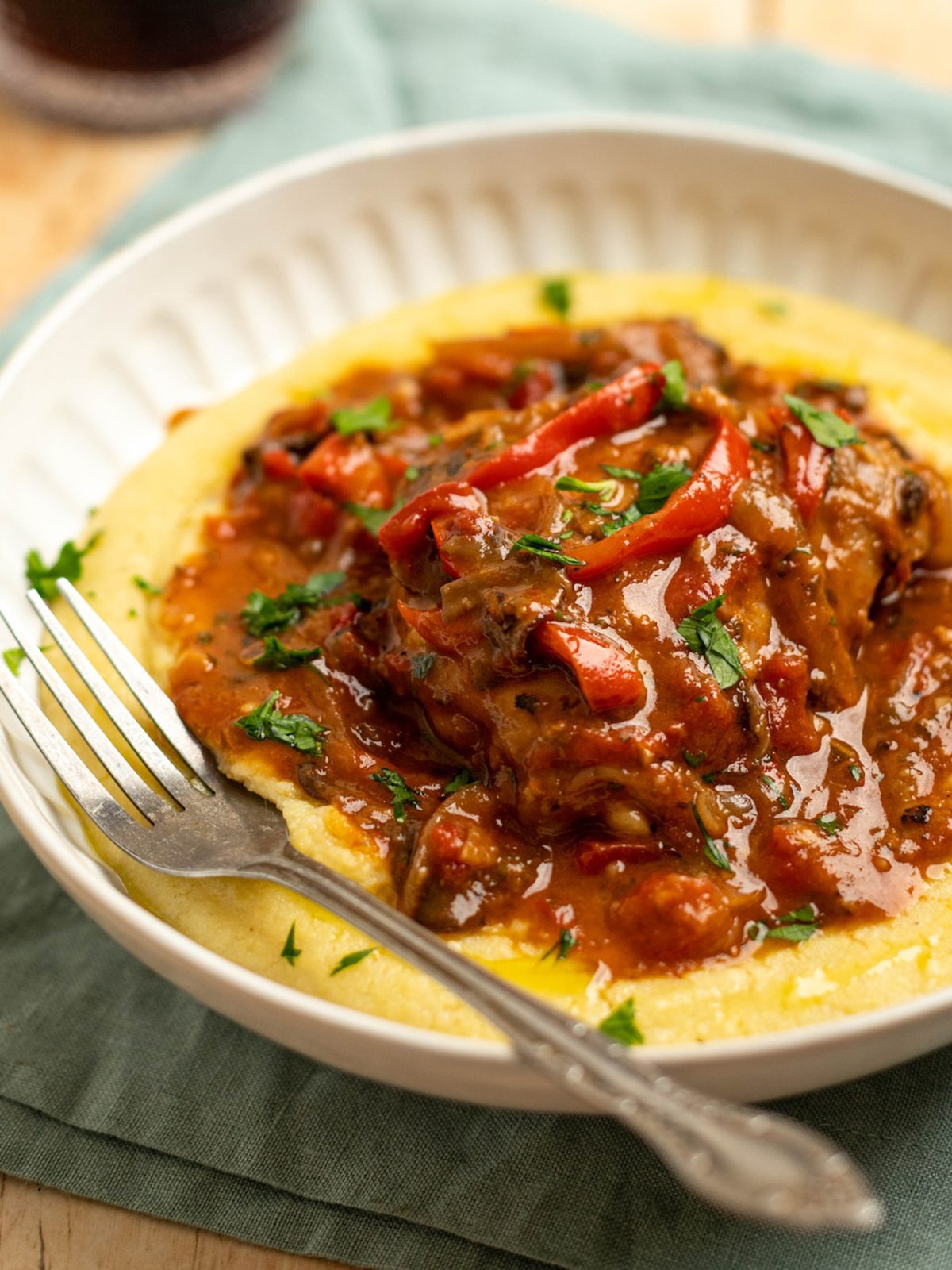
Video Tutorial
More Hearty Chicken Recipes You’ll Love
Chicken Cacciatore
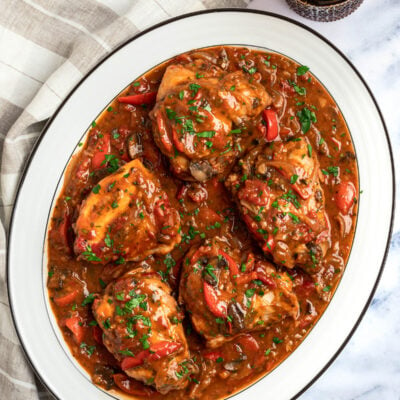
Ingredients
- 8 bone-in, skin-on chicken thighs (about 4 lbs/1.8 kg), trimmed of excess skin (see note)
- 2½ teaspoons salt, divided
- ½ teaspoon freshly ground black pepper
- ½ cup all-purpose flour
- 2 tablespoons extra virgin olive oil
- 1 large yellow onion, halved and thinly sliced
- 6 cloves garlic, minced
- 8 ounces bella or cremini mushrooms, sliced
- 2 red bell peppers, cut into ¼-in (6-mm) strips
- ¾ cup dry red wine (see note)
- 2 cups chicken broth
- 1 (14.5-oz) can fire-roasted or regular diced tomatoes
- ¼ cup tomato paste
- 2 tablespoons chopped fresh sage
- 1 tablespoon chopped fresh rosemary
- 1 teaspoon dried oregano
- 1 tablespoon honey
- Fresh chopped parsley, for garnish (optional)
Instructions
- Blot the chicken with a paper towel to remove any excess moisture. Season the chicken all over with 1½ teaspoons salt and the pepper. Place the flour on a large plate. Dredge the chicken pieces in the flour, coating all over.
- Heat the oil in a large (5-qt/5-L) Dutch oven or heavy-bottomed, high-sided large skillet over medium-high heat. Brown half the chicken in a single layer, skin side down, until golden and crispy, 5 to 7 minutes. Flip and brown on the other side for 1 to 2 minutes more. Using tongs, transfer the chicken to a large plate; set aside. Repeat with the remaining chicken. Pour off all but about 2 tablespoons of the fat.
- Return the pot to the stove and reduce the heat to medium-low. Add the onions to the pot and cook, stirring occasionally, until they are softened and just starting to brown, about 5 minutes. Add the garlic and cook, stirring constantly, until fragrant, about 1 minute. Do not brown. Add the mushrooms and peppers and increase the heat to medium. Cook for 5 minutes, stirring occasionally until the veggies just begin to soften.
- Add the wine and bring to a boil over high heat. Cook, stirring to scrape the brown bits from the bottom of the pan, until the wine has mostly evaporated, 5 to 6 minutes.
- Add the chicken broth, diced tomatoes, tomato paste, sage, rosemary, oregano, honey, and the remaining 1 teaspoon salt. Bring to a boil, then reduce the heat to medium-low and gently simmer, uncovered, for 10 minutes.
- Add the chicken and any accumulated juices from the plate back to the pot, and spoon some of the sauce over it. Bring to a simmer, then cover and cook over medium-low heat for about 35 minutes, until the chicken is cooked through or registers 165 to 170°F (74 to 77°C) on a meat thermometer.
- Using a slotted spoon, transfer the cooked chicken to a plate. Gently simmer the sauce for a few minutes, or until it is thickened to your liking. Taste and adjust seasoning, if necessary.
- Using a fork and knife, pull the skin off of the chicken and discard. Add the chicken and any accumulated juices back to the pot and simmer, uncovered, for a few minutes, spooning the thickened sauce over the chicken. Garnish with parsley, if using, and serve.
Notes
- Sometimes chicken thighs have excess skin and/or fat. Before cooking, using kitchen shears, trim any skin that extends farther than the edges of the chicken thigh, and snip off any excess fat.
- For the wine, use any red (Pinot Noir, Chianti, Merlot, Cabernet Sauvignon, etc.) that is inexpensive but still good enough to drink. Avoid "cooking wines," which are salty and contain additives.
- Make-Ahead/Freezing Instructions: Let cool to room temperature and then store in the refrigerator for up to 3 days, or freeze in an airtight container for up to 3 months. Before serving, defrost in the refrigerator for 24 hours if necessary, and then reheat on the stovetop over medium-low heat until hot.
Pair with
Nutrition Information
This website is written and produced for informational purposes only. I am not a certified nutritionist and the nutritional data on this site has not been evaluated or approved by a nutritionist or the Food and Drug Administration. Nutritional information is offered as a courtesy and should not be construed as a guarantee. The data is calculated through an online nutritional calculator, Edamam.com. Although I do my best to provide accurate nutritional information, these figures should be considered estimates only. Varying factors such as product types or brands purchased, natural fluctuations in fresh produce, and the way ingredients are processed change the effective nutritional information in any given recipe. Furthermore, different online calculators provide different results depending on their own nutrition fact sources and algorithms. To obtain the most accurate nutritional information in a given recipe, you should calculate the nutritional information with the actual ingredients used in your recipe, using your preferred nutrition calculator.
See more recipes:
Comments
Add a Comment Cancel reply
This site uses Akismet to reduce spam. Learn how your comment data is processed.
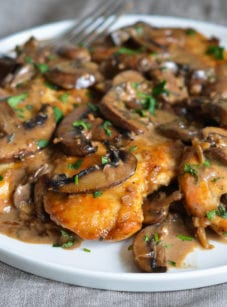
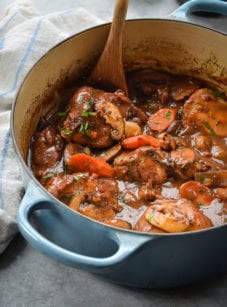
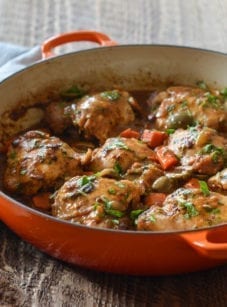
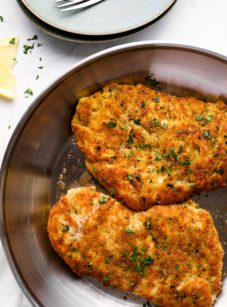
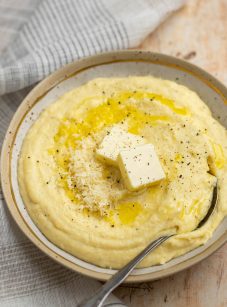
Loved this recipe! Perfect on a rainy day!! Thank you 🙂
Outstanding! Made as written–no changes needed at all. Served with Parmesan polenta. Looking forward to leftovers!!!
Can I use boneless chicken thighs instead?
Hi Carmen, I haven’t tried it with boneless thighs, but you’d like to, I’d only sear the chicken for 1 to 2 minutes on each side, and I think you’ll need to add more oil before cooking the onions and garlic. Hope you enjoy!
I’ve seen chicken cacciatore made with pasta cooked in the same dish. Can this recipe be modified to do this?
Hi Val, while it may be possible, to get perfectly cooked pasta, I’d cook it separately and combine the two at the end.
My wife and I whipped up chicken cacciatore last night, and wow—it was ridiculously delicious. We served it over polenta, which she lovingly drowned in Parmesan cheese. I protested… briefly. Then I took a bite and immediately forgave her. Honestly, if this dish were a person, I’d consider proposing
🤣
Can you use Chicken Breasts instead of Thighs?
Hi Helen, You can use bone-in chicken breasts – just be careful to not overcook them. Enjoy!
Good recipe. Two small changes: (1) instead of diced tomatoes, use whole canned tomatoes cut into chunks, and (2) throw in some pitted kalamata olives toward the end of simmering.
We have a mushroom allergy in the family… Recommend a substitution?
Hi Kathryn, you could use more red pepper or incorporate diced carrots in place of the mushrooms. Hope you enjoy!
Can I substitute boneless thighs for bone-in thighs?
I do not drink. So, what is the non-alcoholic substitute for wine?
Thank you.
Hi Mindy, I haven’t tried it but you’d like to, I would only sear the chicken for 1 to 2 minutes on each side, and I think you’ll need to add more oil before cooking the onions and garlic. And I’d replace the wine with more chicken broth. Hope you enjoy!
This was outstanding!!